Page Table of Contents
About the Author
Hot Topics
Updated on Mar 28, 2025
If you cannot distinguish between system cloning and system migration, you only need to go by their names. Cloning means creating an exact copy of the existing system, and migration generally transfers data or information from one system/disk/drive to another. Through this article, we will learn about system cloning vs system migration and their differences in detail.

The difference between these depends on the real-time purpose of the operations we use. The procedure you should opt for depends on your targets, like whether you want an exact copy of the existing system or to move files from one system to another, as discussed above.
What Is System Clone and System Migration
Now you know what cloning and migration mean, let us get to the actual definitions and use cases in the subsequent sections.
System cloning in computers or PCs refers to creating an exact copy of the existing system for backup or Data transfer. Or remake your Computer's Operating system and all its settings, data, and information to get identical systems.
System Migration in computers transfers the data, settings, or user environment between two computers. We often see this when people buy a new PC rather than redo everything. They migrate all the requirements to the new one with the help of hard drives.
System Clone VS System Migration: What's The Differences
You already know the main difference between system migration and clone disk. Please look at the table below to note the significant differences between them.
| System Clone | System Migration |
|---|---|
| Makes an exact copy of the system, including data, applications, and system settings. | Transfers the required or desired data to another PC. |
| The final output is a bit-by-bit copy of the original one. | The new system contains only the transferred data and applications. |
| Used in the cases of backup and similar system configurations. | Used when upgrading to a new version or moving a specific system from one OS to another. |
| The process is carried out using bootable CDs or USBs with cloning software. | This can be done using migration software, manually transferring using cables, or with the help of cloud services. |
System Clone VS System Migration: When To Use It?
The main goal is to choose a process to achieve your desired target. Let us know the scenarios where we can practically implement these processes. We will also discuss the pros and cons of system cloning and migration.
1. When to Use System Clone
A clone creates an exact copy, so let us think of user scenarios where we make copies for practical purposes.
1. Backup of the existing system: If you are using software or working on a critical system, we can create a copy (backup) in case of failures, system corruption, and data loss.
2. Identical systems: Let us assume your company has multiple branches, and you develop a security mechanism to guard your premises. Rather than creating separate software for each branch, you can clone the system and deploy it in different branches.
3. Testing purposes: To test software or systems in real time, we can create clones, test them, and make changes to our original system in case of any faults or downsides.
| Pros | Cons |
|---|---|
| We can quickly replace and get back to work in system failures. | If you want to upgrade to a new version or server, you will have to set up the entire system again with compatible hardware and OS. |
| Easily create multiple identical systems for deploying a large number of systems. | If the cloning process is not conducted correctly, it could lead to data loss or corruption in the original system. |
| Testing and debugging the systems gets easier. |
2. When to Use System Migration
Just like cloning, we need to understand the practical scenarios to adapt the migration processes in our work.
1. Upgrading to a new system: If you want to move all your current work and applications onto better compatible hardware and OS ( for example, an upgraded PC), we can opt for migration.
2. Transferring selective data: If you want to move only selective information and files to a new system, migration is the best way to do it.
3. Effective use of cloud services: You can move your data to cloud-based computing services or storage to run the system on cloud servers, reducing costs and improving scalability.
| Pros | Cons |
|---|---|
| Ability to select what data you want to transfer. | Migration can be a complex process, requiring specialized software and organization knowledge. |
| Merging many systems or servers into a powerful one. | Time-Consuming |
| It may corrupt or malfunction the new system in the case of an original faulty system. |
Best Software for System Clone and System Migration
In the previous sections, we discussed the software for cloning and migration. These operations may sound simple if you go by their names, but the whole thing depends on the tool you are using.
If you wonder, "Is there a tool that enables people to execute system clone and system migration operations?" then EaseUS Partition Master Professional is your solution.
EaseUS Partition Master specializes in managing partitions on hard drives, SSDs, and external disks. Apart from managing the partitions on your computer, it has exclusive features to clone and migrate software for systems. The cloning feature helps you duplicate partitions or disks without any data losses. And the migration software can transfer your data and applications onto the new ones without malfunctions.
All the processes are safe and secure with no complications and can be completed in a few simple clicks. Let us move to the next parts to learn the steps we need to follow to clone and migrate the systems using EaseUS Partition Master. Download the software tool and follow this guide to complete these complex operations in simple steps.
1. Guide to Clone System
Step 1. Launch EaseUS Partition Master, go to the Disk Clone tab, select "Clone OS Disk" and click "Next".
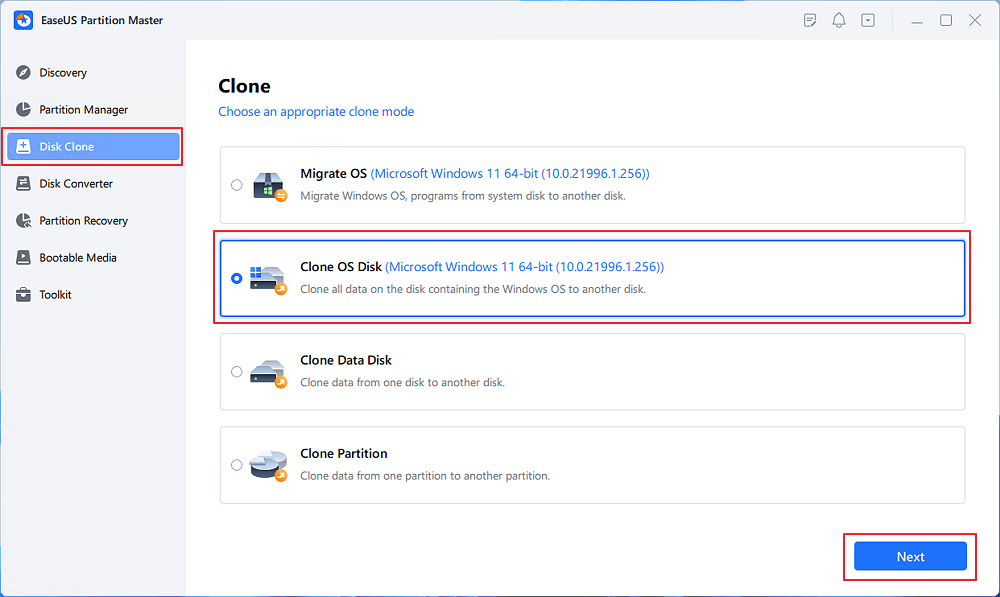
Step 2. Select the target new drive where you want to clone the OS to, and click "Next".
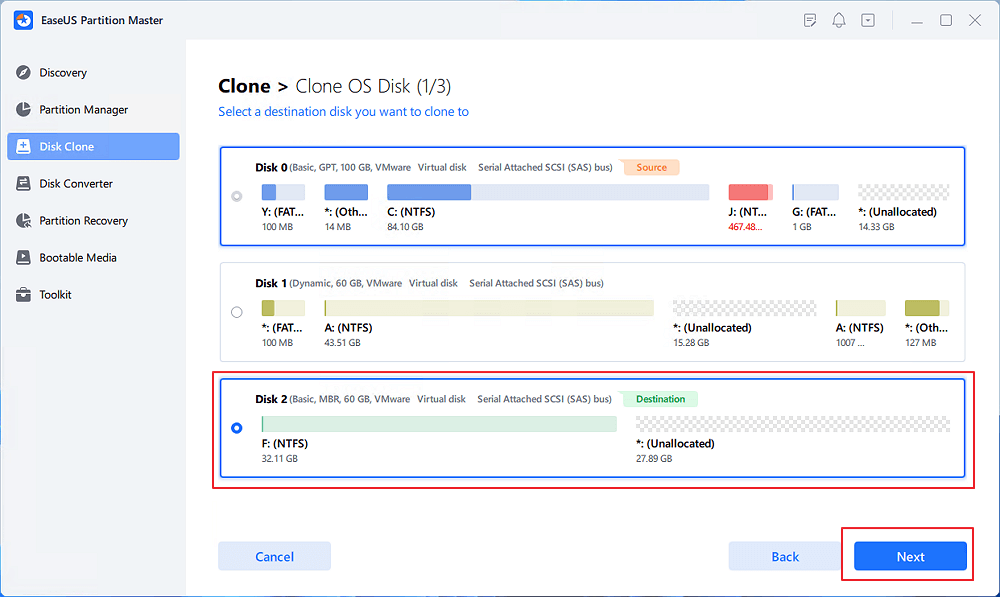
Click "Yes" to confirm that you want to continue the OS disk cloning process.
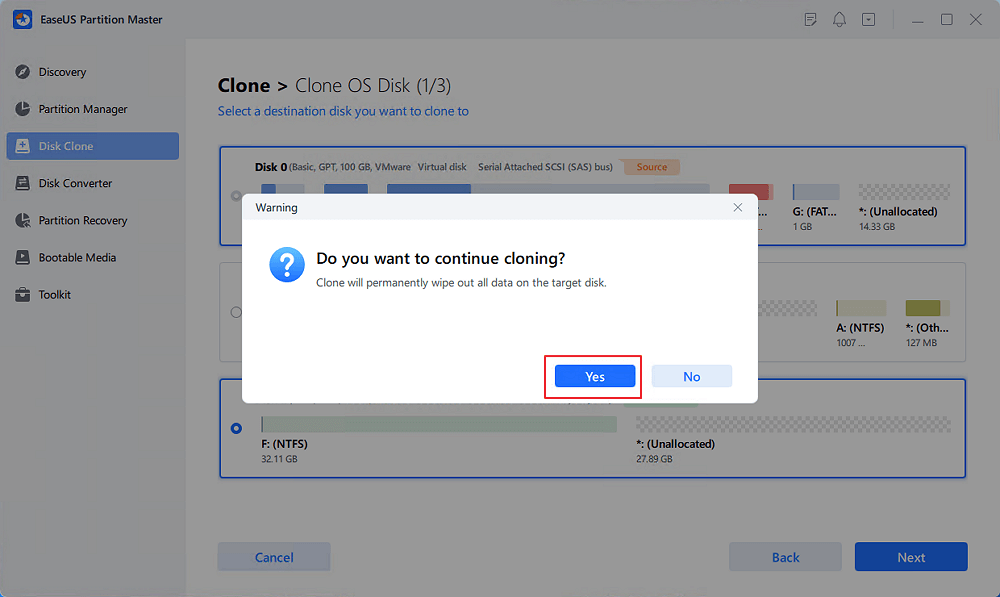
Step 3. View the disk layout, and click "Start" to begin the OS cloning process.
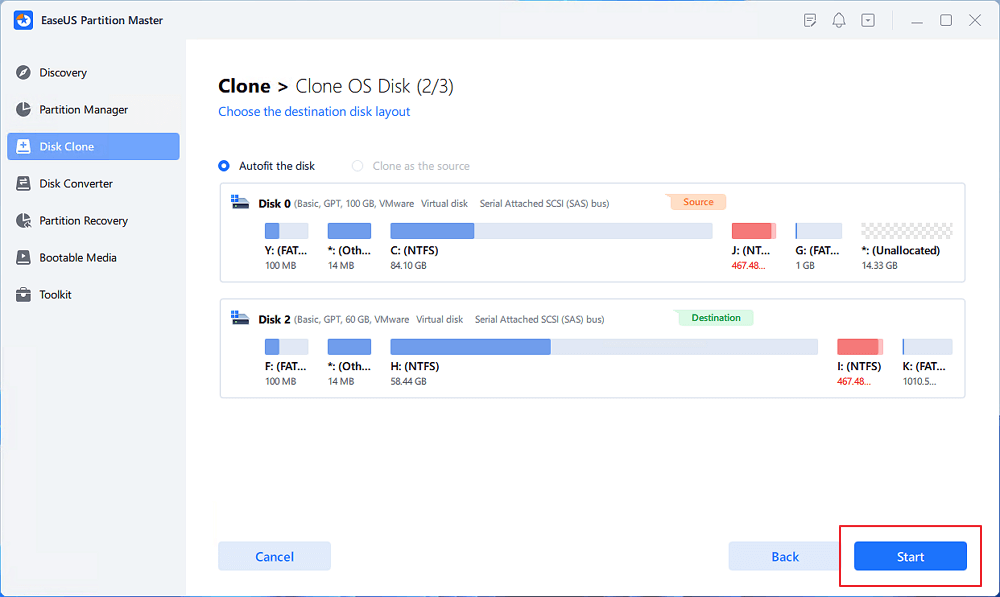
Step 4. When the process completes, you'll see a confirming message, asking "if you want to start up computer from the clone target disk".
- Reboot Now means to reboot your PC and configure the computer to boot OS from the new disk immediately.
- Done means you want to make the changes later.
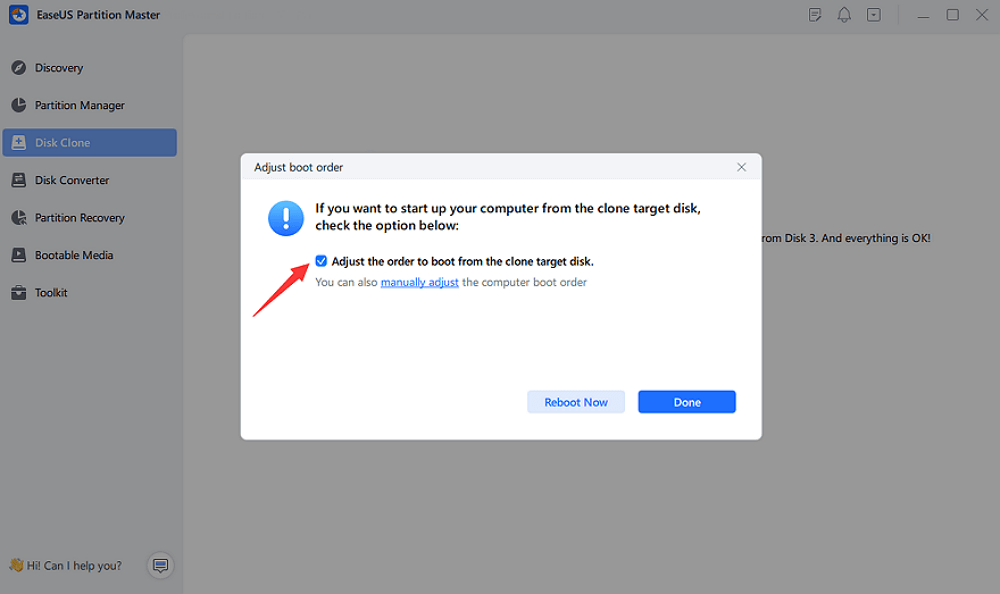
2. Tutorial to Migrate System
Steps to migrate OS to HDD/SSD:
- Run EaseUS Partition Master, and select "Clone" from the left menu.
- Check "Migrate OS" and click "Next".
- Select the SSD or HDD as the destination disk and click "Next".
- Check Warning: the data and partitions on the target disk will be deleted. Make sure that you've backed up important data in advance. If not, do it now.
- Then click "Yes".
- Preview the layout of your target disk. Then click "Start" to start migrating your OS to a new disk.
- After this, click "Reboot Now" or "Done" to determine if you want to reboot the computer from the new disk immediately.
"Reboot Now" means to keep the changes instantly, while "Done" means you need to restart the computer later manually.

Note: The operation of migrating OS to SSD or HDD will delete and remove existing partitions and data on your target disk when there is not enough unallocated space on the target disk. If you saved important data there, back up them to an external hard drive in advance.
IMPORTANT: Change BOOT Drive After System Clone or System Migration
Regardless of whether you need to migrate the OS or clone the system to a new disk and use the system on a new disk, as long as you need to use the system to boot up from your PC, remember to configure the new disk with cloned or migrated system as the boot drive.
Here are the steps:
- Install the new disk by cloning or migrating OS to the PC.
- Restart your PC and press F2/F8/Del to enter BIOS settings.
- Go to the Boot Menu and set the new disk with the cloned or migrated system as the boot drive.
- Press F10 or click Save and Exit to reboot the PC from the new disk.
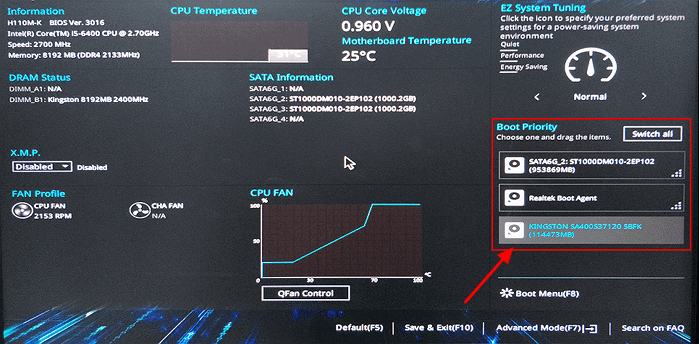
The Final Verdict
As the names refer, the system clone refers to the exact copy of the original system. System migration is moving required data and applications from one system to another. The method you need to opt for will be based on your purpose, and refer to the uses to get an idea about it.
Once you have decided on the process, you can use the specialized EaseUS Partition Master to complete this in a few clicks. Refer to the guide to complete this tiring process efficiently.
If you find this article helpful, share it with your friends and leave a comment about it. If you have any queries regarding the topic, feel free to ask them in the comment box, and do let me know of the future issues you wish to see articles from EaseUS.
FAQs About System Clone VS System Migration
Here are some of the most frequent FAQs asked on the topic. If you have similar queries, I hope this will help you.
1. What is the difference between cloning and migration?
The fundamental difference lies in the names; cloning refers to making a copy of something, and migration means moving something. As far as computer systems are concerned, system cloning is a process of making a bit-by-bit copy of an existing system, and system migration is moving or transferring data and applications onto a new system or disk.
2. What is a system clone?
System cloning in computers or PCs refers to creating an exact copy of the existing system for backup or data transfer. Or remake your Computer's Operating system and all its settings, data, and information to get identical systems.
3. What is the difference between a disk clone and a system clone?
System migration vs clone disk, what's the difference? The significant differences lie in the circumstances in which you use these operations. A disk clone or disk image is created if your hard drive is corrupted due to malware, bad sectors, or virus attacks. The system clone is created if you want to sell your device or replace your hard drive to back up all the relevant data, applications, and programs onto a new one.
How Can We Help You
About the Author
Roxanne is one of the main contributors to EaseUS and has created over 200 posts that help users solve multiple issues and failures on digital devices like PCs, Mobile phones, tablets, and Macs. She loves to share ideas with people of the same interests.
Written by Tracy King
Tracy became a member of the EaseUS content team in 2013. Being a technical writer for over 10 years, she is enthusiastic about sharing tips to assist readers in resolving complex issues in disk management, file transfer, PC & Mac performance optimization, etc., like an expert.
Product Reviews
-
I love that the changes you make with EaseUS Partition Master Free aren't immediately applied to the disks. It makes it way easier to play out what will happen after you've made all the changes. I also think the overall look and feel of EaseUS Partition Master Free makes whatever you're doing with your computer's partitions easy.
Read More -
Partition Master Free can Resize, Move, Merge, Migrate, and Copy disks or partitions; convert to local, change label, defragment, check and explore partition; and much more. A premium upgrade adds free tech support and the ability to resize dynamic volumes.
Read More -
It won't hot image your drives or align them, but since it's coupled with a partition manager, it allows you do perform many tasks at once, instead of just cloning drives. You can move partitions around, resize them, defragment, and more, along with the other tools you'd expect from a cloning tool.
Read More
Related Articles
-
[Full Guide] How to Rebuild MBR | Fix Damaged MBR
![author icon]() Daisy/2025/01/16
Daisy/2025/01/16 -
How to Fix Service Host Superfetch High Disk Usage
![author icon]() Brithny/2025/01/23
Brithny/2025/01/23 -
[Solved] Antimalware Service Executable High Memory/Disk Windows 11/10 2025
![author icon]() Brithny/2025/01/23
Brithny/2025/01/23 -
How to Split Partitions with Complete Guide
![author icon]() Daisy/2025/03/29
Daisy/2025/03/29
Hot Topics in 2024
EaseUS Partition Master

Manage partitions and optimize disks efficiently








